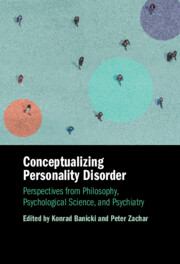 Conceptualizing Personality Disorder
Conceptualizing Personality Disorder Book contents
- Conceptualizing Personality Disorder
- Conceptualizing Personality Disorder
- Copyright page
- Contents
- Figures
- Tables
- Contributors
- Introduction
- Part I Historical Perspectives
- Part II Contemporary Approaches to Traditional Conceptual Perspectives
- Part III Novel Conceptual Approaches to Personality Disorder
- 10 What Does Personality Have to Do with Mental Disorder?
- 11 Self-Illness Ambiguity in Personality Disorders
- 12 On Personality Dimensions and Disorders
- 13 A Dual-Aspect Approach to Personality Disorder
- 14 Network Architectures of Personality and Its Pathology
- 15 From Paul Tillich’s The Courage to Be to Radical Acceptance and Radical Openness
- 16 Personality “Disorder” and the Incapacity to Self-Regulate
- Part IV Exploring Negative Consequences of Diagnosing Personality Disorder
- Part V Perspectives on Borderline and Narcissistic Personality
- Index
- References
10 - What Does Personality Have to Do with Mental Disorder?
A Cybernetic Perspective
from Part III - Novel Conceptual Approaches to Personality Disorder
Published online by Cambridge University Press: 25 June 2025
- Conceptualizing Personality Disorder
- Conceptualizing Personality Disorder
- Copyright page
- Contents
- Figures
- Tables
- Contributors
- Introduction
- Part I Historical Perspectives
- Part II Contemporary Approaches to Traditional Conceptual Perspectives
- Part III Novel Conceptual Approaches to Personality Disorder
- 10 What Does Personality Have to Do with Mental Disorder?
- 11 Self-Illness Ambiguity in Personality Disorders
- 12 On Personality Dimensions and Disorders
- 13 A Dual-Aspect Approach to Personality Disorder
- 14 Network Architectures of Personality and Its Pathology
- 15 From Paul Tillich’s The Courage to Be to Radical Acceptance and Radical Openness
- 16 Personality “Disorder” and the Incapacity to Self-Regulate
- Part IV Exploring Negative Consequences of Diagnosing Personality Disorder
- Part V Perspectives on Borderline and Narcissistic Personality
- Index
- References
Summary
There are no such things as “personality disorders” distinct from other mental disorders. Distinct personality disorders cannot be identified based on their developmental course or their symptoms. The new ICD and DSM concept of personality disorder as self and interpersonal dysfunction identifies important forms of psychopathology but is not more (or less) related to personality than are other disorders. Rather, personality traits contribute to risk for all forms of mental disorder, and most symptom dimensions are coextensive with dimensions of normal personality, such that persistent symptoms of psychopathology are typically extreme or maladaptive variants of normal personality traits. However, symptoms are merely indicators of risk rather than necessary and sufficient indicators of psychopathology. We draw on our cybernetic dysfunction theory of psychopathology to clarify the role of personality in mental disorder. Psychopathology is defined as “persistent failure to move toward one’s goals, due to failure to generate effective new goals, interpretations, or strategies when existing ones prove unsuccessful.” Personality is exhaustively described by personality traits and characteristic adaptations, the latter being relatively stable goals, interpretations, and strategies that are specified relative to an individual’s particular life circumstances. Psychopathology always involves failure of characteristic adaptations and thus breakdown in personality functioning.
Information
- Type
- Chapter
- Information
- Conceptualizing Personality DisorderPerspectives from Philosophy, Psychological Science, and Psychiatry, pp. 181 - 195Publisher: Cambridge University PressPrint publication year: 2025